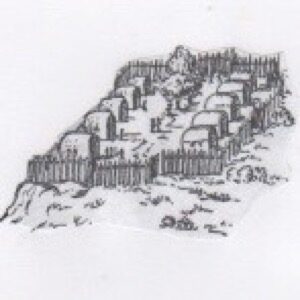
Ray Tubbs – Fort Hill (built early 1600s)
A tribe of the Eastern Algonquian, the Podunk were part of one of the three so-called River Tribes who lived on both sides of the Connecticut River in what is now the Hartford area. The Podunk, living on the eastern side, were divided into three bands, the one in now East Hartford was the Hockanum. Among the tribes were ever-shifting sub-tribes, bands, clans, and kinship groupings. Their leaders or chiefs were called sachems.
The Algonquian Peoples were one of the most populous and widespread North American native language groups. Linguistically related, the tribes ranged south of Hudson Bay from the Atlantic coast to the Rocky Mountains – from the Abenaki of Maine, to the Mohegan-Pequot of Connecticut, the Delaware, to the Ojibwe of the Great Lake regions to the Chippewa of the Dakotas. The Eastern Algonquians practiced a seasonal economy. Villages, ranging in size of a few hundred, tightly-knit members, were temporary and mobile, often breaking into smaller units and recombining as circumstances required.
In warm weather they constructed portable lightweight wigwams – sapling frames covered with skins and birch bark. In the winter they built multi-family longhouses. In the warm months they camped near rivers living on fish such as salmon, shad and eels; berries and greens; migratory birds, like ducks, and their eggs. Plus, the men hunted deer, bear and small game. They also practiced a slash and burn policy to temporarily clear land for growing squash, beans and corn. This resulted in the English settlers finding much already cleared land ready for own planting. During the winter they moved inland to campsites in the heavily wooded forests. Their diet in great part being dried venison and bear meat.
East Hartford, the marshes along the Hochanum River from its mouth at the Connecticut River, was the summer living area of a Podunk band. Thus their name: “Podunk” meaning “a boggy place” in their Algonquian dialect. The Podunk, a tribe consisting of 3 bands. lived between the Hochanum River in the south to the the Podunk River in the north.
Unfortunately a characteristic of the Eastern Algonquian was an inability to see the advantages and increased influence to be gained through intertribal organization and pragmatic combining of forces as needed. Thus, by the time the first white settlers arrived in New England intertribal warfare was already tearing apart the very fabric of Eastern Algonquian life.
The small and peaceful River Tribes lived in constant fear of raids by the aggressive, marauding Pequots and Mohegans ever seeking expansionistic control. It was for this reason the Podunk fortified, with a log palisade, this steep-sided site to be called “Fort Hill” by later townspeople.
Seeking allies out of desperation, in the early 1630s the River Tribes sent a delegation, including Tantonimo, the leader of the Podunk Hockanmum Band, to the Puritan Settlement in Cambridge beseeching some of them to settle in what is now Hartford. Thus the Rev. Thomas Hooker and his party came to form the Hartford Settlement. In spite of the help the Puritans received for surviving their first winter by tribal members, there was much mutual distrust. It was a very problematic relationship which the tribes found confining and restricting in numerous frustrating and humiliating ways. In addition, the tribes, including the Podunk, suffered high rates of mortality from infectious endemic diseases carried by the colonists.
In King Philip’s War from 1675-76, the Podunk allied with the rebellious Metacom (called King Philip by the English), a sachem of the Wampanoag who eventually lost this devastating war. From battle and disease, the warrior base of the Podunk, as with the other allied tribes, was virtually wiped out. They never recovered. You can learn more of this conflict at the site of Obadiah Wood, a Yankee veteran of the war, which was also know as the Narragansett Wars.
By 1736 the remnants of the Podunk and other tribes combined with others to form the Schagticoke tribe and by the early 1750s they were virtually extinct and disappeared from history.
Postscript: Town residents found Podunk artifacts in Center Cemetery, in and around the site of Fort Hill, well into the 20th century. Unfortunately no formal records of these objects, identified and cataloged as being Podunk, were ever kept so even they are lost to history.